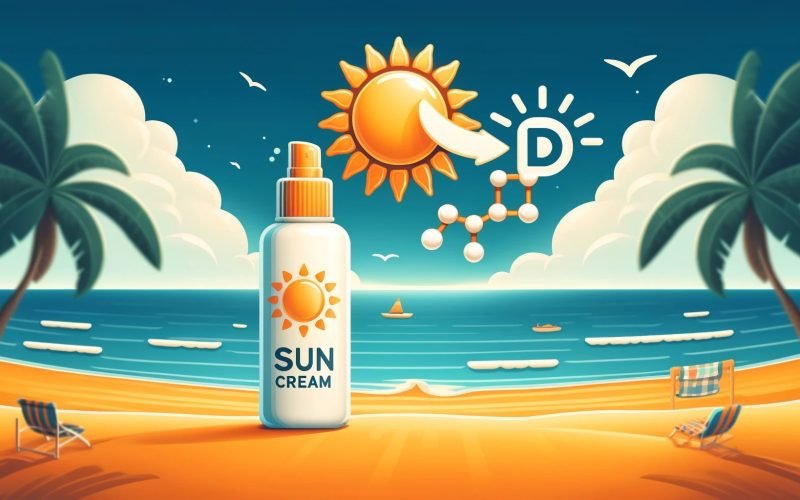The sun: a celestial body that is both friend and foe. As much as it fills our days with light, it poses risks with its ultraviolet (UV) rays. Yet, it’s also our primary source of vital Vitamin D. Striking a balance between soaking up enough rays for good health while protecting ourselves from potential harm is a fine art. This comprehensive guide will detail how to manage sun exposure judiciously, with the help of protective sun cream, ensuring you reap the benefits of Vitamin D without compromising your skin’s safety.
Harnessing Vitamin D: Smart Sun Exposure Strategies
Vitamin D, endearingly known as the “sunshine vitamin,” is synthesized by our skin when it’s exposed to UVB rays. This nutrient is essential for bone health, immune function, and mood regulation. Many of us, especially those in colder climates, struggle to maintain adequate Vitamin D levels. Thus, understanding how to maximize its production during safe sun exposure is vital.
Understanding UV: Balancing Skin Protection and Sun Benefits
UV rays, particularly UVA and UVB, have distinct roles when it comes to our skin. While UVB is crucial for Vitamin D synthesis, both UVA and UVB can contribute to skin damage and increase the risk of skin cancer. Protective sun creams with a broad spectrum are specifically formulated to shield the skin from these rays.
Sun Cream’s Role in Vitamin D Synthesis
The quandary often arises: if sun cream blocks UV rays, does it prevent Vitamin D synthesis? The answer isn’t straightforward. No sun cream blocks 100% of UV rays; thus, even with sun cream, you can produce Vitamin D. However, it’s about the duration and timing of sun exposure. A short, unprotected sun exposure—about 10 to 15 minutes for fair skin and up to 30 minutes for darker tones—can suffice for Vitamin D production before applying sun cream.
Timing Your Sun Exposure for Maximum Vitamin D Gain
Seeking the sun when it’s at its zenith, between 10 a.m. and 3 p.m., is usually advised for the best Vitamin D synthesis. That’s when UVB rays are most potent. However, this is also when the sun is most dangerous for the skin. Hence, timing your unprotected exposure outside of peak UV intensity times, like early morning or late afternoon, might be safer for your skin while still beneficial for Vitamin D.
Complementing Sun Cream with Protective Gear for Safe Sun Time
In addition to sun cream, other protective measures can be part of your sun strategy. Clothing, wide-brimmed hats, and sunglasses can significantly reduce your risk of UV damage. Fabrics with a tight weave and UV-protective clothing are especially effective. Moreover, seeking shade during peak hours can provide a respite for your skin while still enjoying the outdoors.
The Role of Sun Cream in Skin Cancer Prevention
Continuing with protective measures, it’s critical to address the role of sun cream in preventing skin cancer. Regular application of a high-SPF sun cream not only guards against sunburn but also helps to prevent squamous cell carcinoma and melanoma. Remember, while Vitamin D is important, protecting your skin from cancer and premature aging takes precedence.
Vitamin D from Diet and Supplements
When sun exposure is not possible, Vitamin D can also be obtained from diet and supplements. Foods rich in Vitamin D include fatty fish, egg yolks, and fortified foods. Vitamin D supplements can be a reliable source as well, particularly during winter months or for individuals with limited sun exposure.
Sun Cream Application Tips for Effective Protection
To ensure effective protection when you do apply sun cream, follow these tips:
- Apply generously and evenly 15 minutes before going outdoors.
- Reapply at least every two hours, and immediately after swimming or excessive sweating.
- Use a water-resistant formula if engaging in water activities or if you expect to sweat.
Understanding SPF Ratings
The Sun Protection Factor (SPF) rating of a sun cream indicates the level of protection it provides against UVB rays. However, a higher SPF does not mean you can stay in the sun longer. It’s the reapplication that matters most, along with the aforementioned timing for Vitamin D synthesis.
Nurturing Sun-Damaged Skin
If you do end up with sun-damaged skin despite your efforts, it’s important to nurture it back to health. Aloe vera, cooling gels, and moisturizers designed for after-sun care can soothe and repair the skin. If you notice severe or persistent skin changes, consult a dermatologist.
Conclusion
The interplay between UV rays, sun cream, and Vitamin D is intricate but navigable. By understanding the dynamics of sun exposure, you can enjoy the benefits of the sun while minimizing risks. Adequate protection with sun cream, smart timing, and additional measures can all contribute to a healthy, sun-smart lifestyle. Embrace the sun with respect and knowledge, and let both your skin and health thrive under its glow.





